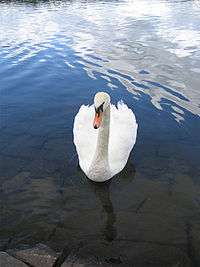Le cygne

"Le cygne" (The Swan)
"Le cygne" performed by John Michel. Camille Saint-Saëns's "Le cygne" (The Swan)
 Alisa Weilerstein and Jason Yoder perform Camille Saint-Saëns's "Le cygne" in a marimba-and-cello arrangement at the White House Evening of Classical Music (2009-11-04) Camille Saint-Saëns's "Le cygne" (The Swan)
Audio only Weilerstein and Yoder version | |
| Problems playing these files? See media help. | |
Le cygne, pronounced: [lə siɲ], or The Swan, is the 13th and penultimate movement of The Carnival of the Animals by Camille Saint-Saëns. Originally scored for solo cello accompanied by two pianos, it has been arranged and transcribed for many instruments but remains best known as a cello solo.
Music
The piece is in 6/4 time, with a key signature of G major and a tempo marking andantino grazioso. The slow cello melody is accompanied by almost constant broken chord figurations on the pianos. When performed as a separate movement, not in the context of The Carnival, The Swan is frequently played with accompaniment on only one piano.
This is the only movement from The Carnival of the Animals that the composer allowed to be played in public during his lifetime. He thought the remaining movements were too frivolous and would damage his reputation as a serious composer.
Because of its slow tempo and mostly legato performance indications, the movement is suitable for performance on the theremin and has joined Sergei Rachmaninoff's Vocalise and Jules Massenet's Méditation from his opera Thaïs among the classical works central to the theremin repertoire.
Uses in choreography
Le cygne is often known as The Dying Swan, after a poem by Tennyson. Inspired by swans that she had seen in public parks, Anna Pavlova worked with choreographer Michel Fokine, who had read the poem, to create the famous 1905 solo ballet dance which is now closely associated with this music. According to tradition, the swan in Pavlova's dance is badly injured and dying. However, Maya Plisetskaya re-interpreted the swan simply as elderly and stubbornly resisting the effects of aging; much like herself (she performed The Swan at a gala on her 70th birthday). Eventually the piece came to be considered one of Pavlova's trademarks.[1]
In 1949 the American synchronized swimmer Beulah Gundling created a routine inspired by Fokine's choreography and entitled The swan to Le cygne by Saint-Saëns.[2]
Transcriptions and adaptations
In the 1890s, Louis van Waefelghem adapted Le cygne for viola or viola d'amore and piano. The edition was published by Durand in 1895.
In Leonard Bernstein's famous recording of the piece with the New York Philharmonic the melody is performed on double bass by a 20-year-old Gary Karr.
Montserrat Caballé recorded a version in which she vocalizes sections of the melody accompanied by a piano.
In the early 20th century, Clara Rockmore, the renowned thereminist, performed it on theremin with her sister Nadia Reisenberg accompanying her on the piano.
Steven Mead arranged the piece for Euphonium and Piano in 1995, in the key of Eb Major.
References
- ↑ Garafola, Lynn (2005). Legacies of Twentieth-century Dance. New York: Wesleyan University Press. pp. 155–156. ISBN 978-0-8195-6674-4.
- ↑ Michael Heim, Exploring Iowa Highways, Wabasha 2006, page 88. Information about the book on Google website.
External links
- Public-domain scores and recordings in the Petrucci Music Library
- Performance of Godowsky's transcription of The Swan for solo piano by Jiyang Chen
- MP3 file of Le cygne
- Performance of Le cygne